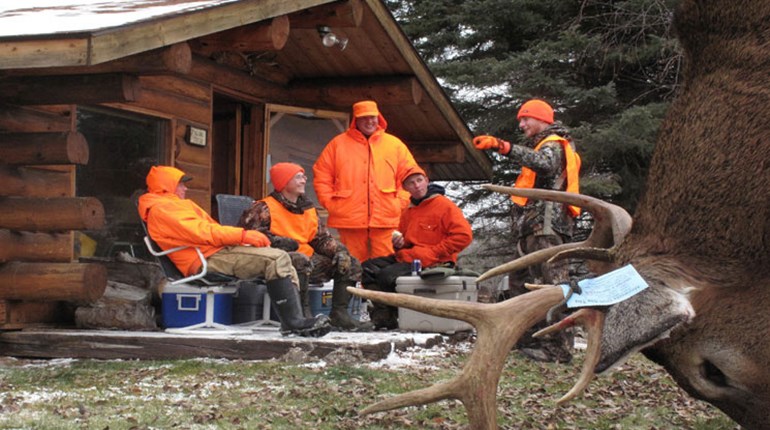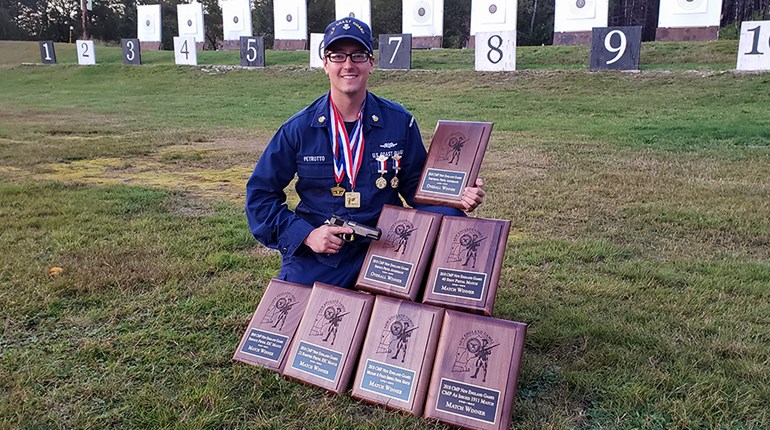For a few weeks in October New England forests are awash with an impressionist’s pastels. Soon the color drips in fallen leaves to the forest floor where grouse drum and the Robert Frost poem “October” seems to be whispered by the wind. (“O hushed October morning mild; Thy leaves have ripened to the fall … .”)
Now, though we’re seduced by the natural splendor, we’re careful how much we say so. Articulating such things just isn’t manly. It isn’t what hunters do. But, as I crumble under a maple on a colorful mountain, I know it isn’t just the cagey ruffed grouse that drew me north to Vermont’s Northeast Kingdom in late October.
I kick yellow leaves in frustration. I know too well why the word “grousing” was coined. I’d crunched down an overgrown logging road under trees shedding a rainbow of hardwood leaves and when the flush finally came the bird blasted off behind me. I turned, shot off-balance and missed badly. The miss reminded me that New England grouse hunting is for masochists.
I grew up breaking brush and shouldering a gun all of a sudden when this brown-and-gray game bird boomed its wings, rocketing up and twisting away. I got glimpses of it only when I was fortunate. Now I’m reminded that the past can be mischievous, even a shape-shifter. Time slips by but doesn’t just peel away as memories fade; no, the memories can also grow more golden—recollections thereby become masters of spin.
Maybe that’s what drew me north to hunt grouse. Surely I was influenced by memories whispering things like: Don’t you want to drive the meandering byways over red covered bridges? Don’t you want to see the autumn sun making color-splashed trees shine like fallen rainbows as you hunt for the explosive ruffed grouse? Come on, this is when the words from Corey Ford’s “The Road to Tinkhamtown” are tossed over a mountainous landscape; this is when grouse drum and woodcock wing through; this is when a bird dog becomes part of living art … . And so go the one-sided and awfully wistful deceptions.
Of course, I concede there must be sparks of truth in the remembrances because Corey Ford himself wrote in that elegant story: “The past never changes. You leave it and go on to the present, but it is still there, waiting for you to come back to it.”
He’s right, I know; it’s just that there is a lot more to the experience than grouse booming up into bright canopies as a shotgun is shouldered and a shot made or more likely missed. There’s realism too. There is sweat and frustration. There is breaking brush and slipping on slick, new-fallen leaves somewhere on vertical hillsides. There are attempts to cross beaver ponds that end in soaking boots … . But okay, I also concede such obstacles make the triumph of a well-done shot all the more significant. Ruffed grouse in New England don’t rise and arc away like South Dakota’s pheasants, they make you earn them.
Also, these fading New England covers are what the Beaverkill River is to trout fishermen and what the Chesapeake Bay is to duck hunters; they’re a link to generations before, to American hunters who began our traditions.
So sitting there in yellow leaves on that Vermont mountain, I let the past stir into the present and start to laugh at the whole thing as such nostalgia is a little comical after all. I think of the bed-and-breakfast I’d checked into the night before. It’s in a town so small it doesn’t have a stoplight but there are nevertheless four churches crowding the square, each trying to be a picturesque image on a New England postcard. The B&B’s Queen Anne-style tower and porch are something Norman Rockwell might have sketched. And it’s not just a happy façade hiding a complex life. There is truth in the postcard image. The couple running the B&B left the busy life for the quiet, old-time days of welcoming guests into their Victorian home. He left Florida to be Bob Newhart in the actor’s most iconic part. She is a Vermont native who moved to Boston before fleeing the busy metropolis and literally tossing her cell phone into a local lake to say goodbye to all that.
The only other guests are a retired couple from London enjoying an autumn “jape across the bright countryside.” They hope to see a moose. I comment that moose are in season and are therefore a little shy just now. They ask what I’m up to and I say, “Hunting partridge.” She says, “You mean bird watching, don’t you?” I tell them “No, I mean shooting and eating them.” They become quiet for a minute as they realize they’re not in Thrushcross Grange but in Wuthering Heights. But soon we get along wonderfully, as we now understand one another.
So all the pieces of the event are in place. Perhaps my mood and shooting just have to improve.
I hunt down the mountain and miss again before stepping onto a dirt road that is the shortcut over the mountain and meet two hunters chasing the same dream. They’re up from Bennington. Seeing them walk up the meandering road between stone walls, one in a green-and-black checkered coat and the other in beige upland attire as if trying to be living images from an L.L. Bean catalog, makes me realize that the three of us are trying too hard to be early 20th century clichés of what a New England upland-bird hunter is supposed to look like. Surely we are all trying to live a shared fantasy, an image stoked on winter evenings alongside crackling wood fires and on summer days stuck in air-conditioned rooms. We are chasing an idea centered on grouse because ruffed grouse are an alluring symbol of the New England forest. But then, though we have sore legs and humbled shotgun skills, we’re having a hell of a time. So why not revel in an elusive image?
We sit down on a stone wall some farmer built and abandoned 150 years before that is now buried in red oak leaves and talk about the guileful ruffed grouse.
“We got two woodcock, but the grouse are just making us jumpy,” says the man in the checkered coat.
“I’ve missed three,” says the other, “though I only saw one.”
“Shooting at the flush is grouse hunting, I guess,” I say. “There is no swing and lead here, just point and shoot.”
“True,” says the man in the checkered coat. “I killed a couple of ruffs in Idaho with my bow last year. I could have killed them with a stone. I tried to explain that those are only ruffs genetically, that here in the East they go off like fireworks, but my cowboy elk guide thought I was full of it.”
That night I call Pete Richardson. Pete is the best damn snowshoe hare guide in New England (harehunter.tripod.com) and is always out and about with his beagles, so I know he’ll have an idea where I can find birds. He says he has to work in the afternoon but that if I come to his house by 7 a.m. he’ll take me to a spot where he got 15 flushes the day before.
Who could say no to that?
The next morning as I drive past fields white with frost to meet Pete I know I’m not just chasing dreams, but that I’m also chasing the retreating cover of the ruffed grouse. Grouse hunting, you see, is in decline across much of the East as habitat ages and logging gives way to preservation. The early successional habitat grouse need is hard to find as a forest grows tall and shades out the understory. Northern Vermont, parts of New Hampshire and especially much of rural Maine still have fine hunting but you have to find it. It helps to call a local (see my sidebar for some intel).
In the morning we take meandering byways to within a dozen miles of the Canadian border and go into a privately owned forest being logged. I meet an owner driving a pickup and he asks, “You just hunting birds?”
“If it’s okay.”
“All right,” he laughs, “even if your plates do say New York.”
We drive into a maze of logging roads and see a group of moose hunters. They’re all standing around their vehicle and one is jogging down a cut as a boy follows with a rifle.
“We saw one,” says one of the hunters, “but the bull saw us too.”
We move on to give the moose hunters space and stop near a cutover.
I’ve hunted with Pete for snowshoe hare many times and so am used to his deceiving gate that seems slow but moves with purpose and his humor he won’t even let you guess at until he knows you a bit—a New England trait that takes some getting used to. He tells me about his dogs and we walk the edges of cuts and down grown-over logging roads. I’m caught off-balance with the first flush and almost don’t get the gun on the bird, but then I do and the bird tumbles. I shoot the next so fast it barely rockets a dozen feet. And the day is perfect and the sky blue and the birds everywhere and a dog isn’t necessary. I realize the fantasy of the New England autumn grouse hunt is real, just fleeting.
I find that all that’s a taste of why we chase such fantasies, even if they’re only real for moments. Because there can be a perfect day and that’s enough to stoke winter thoughts and summer daydreams for the next fall, when the leaves brighten and fall and the grouse go off like fireworks and we find that Corey Ford wasn’t just a romantic—sometimes he was a realist.





































